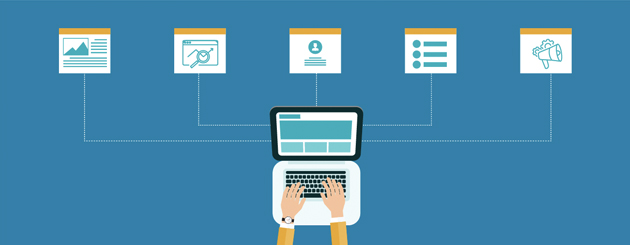



By John Lavey, CEO/President
One word in healthcare marketing seems to be radioactive: retainer.
Historically, healthcare marketing agencies charged retainers and delivered valuable advisory services for that monthly fee, and then charged for time and materials above and beyond the fee for deliverables (design, content, advertising buys, etc.).
The Great Recession, which started in 2007, upended many business models, and was when we started to see traditional marketing transform into what we know think of as digital marketing (2007 was also the same year the first iPhone was introduced). Our company founder, Rex Hammock, framed this revolutionary change as shifting from reliance on other media channels (via ad agencies and PR firms) to taking control of media creation for direct customer outreach.
With traditional agencies rocked by slashed marketing budgets and a whole new paradigm for reaching customers possible with digital marketing, the idea of charging retainers came under pressure. Plus, the labor market was full of former journalists and marketers who could work freelance for healthcare companies to accomplish their marketing needs.
Plenty of agencies still charge retainers. But many healthcare companies began paying for specific deliverables rather than retaining agencies, especially in content marketing and specialized digital marketing. Retainer became a negative word.
While retainers in the old days may have implied money that wasn’t accountable, there is an increased need today for balancing the delivery of assets with the guidance and expertise (and outside perspective) that come from working with a content agency, not just buying a certain amount of content. I’m curious to know how you view this issue. Feel free to let me know!
Image: Getty Images
About Hammock Healthcare Idea Email | This post is part of Hammock’s award-winning Idea Email series. Idea Emails are sent every other week and share one insightful marketing idea. Idea Email comes in two flavors: Original and Healthcare. To subscribe to the original Idea Email (general marketing ideas), click here. To subscribe to the Healthcare Idea Email (healthcare marketing ideas), click here

By Jeff Walter, Senior Healthcare Editor and Writer
One of the most pressing challenges in today’s healthcare environment is access. That one simple concept touches practically every area of what hospitals, clinics, health systems, health plans, home health agencies, provider groups and other healthcare organizations do every day.
There’s access, first and foremost, to care. There’s access to insurance coverage, to specialists, to reliable information (including one’s own records), to assistance in navigating the whole complicated system. The needs are great and the resources, unfortunately, limited. Outsourcing and partnerships can be valuable allies in providing the best care.
The same often proves true in healthcare marketing. How easy are you making it for your patients/customers (and potential ones) to access the information and messages that your organization wants to communicate to them?
Today’s most successful healthcare marketers realize the importance of engaging with consumers across a range of media and platforms. Personalization means reaching people “where they are,” giving them access to useful information at their convenience, on their timetable and on their terms, through their preferred channel(s). From text and email campaigns to blog posts, from e-books to whitepapers, from infographics to videos, from case studies to social media, the methods of reaching your target audience are practically as limitless as your imagination.
There may be limits, however, to the time and other resources that your in-house staff has available to effectively and efficiently craft and curate this content. Whether your team is directly involved in patient care, or it plays a supporting role as a vendor or service provider, consider whether you are content with your content. Might you benefit from access to marketing specialists who can provide critical services as needed? Most companies find such content too specialized and too expensive to create in house.
At Hammock, we have a demonstrated track record of helping healthcare companies market themselves through carefully created content that their varied audiences can actually use. Our experienced researchers, strategists, writers, editors and designers can help your organization forge deeper and longer-lasting relationships with customers—helping instead of hyping, all in the interest of everyone’s good health.
Image: Getty Images
About Hammock Healthcare Idea Email | This post is part of Hammock’s award-winning Idea Email series. Idea Emails are sent every other week and share one insightful marketing idea. Idea Email comes in two flavors: Original and Healthcare. To subscribe to the original Idea Email (general marketing ideas), click here. To subscribe to the Healthcare Idea Email (healthcare marketing ideas), click here

By John Lavey, President and CEO
Helping customers be more successful at solving a problem or pursuing a passion is good marketing. Being able to share information that no one else has access to, or hasn’t taken the time to aggregate in a meaningful way, is particularly powerful.
Some of our clients have access to large data sets that can be mined to share trends, like payer trends related to claims reimbursement. Others have packaged publicly available information in a way that is specifically helpful, such as a monthly update on the status of every state’s CMS waiver.
It’s a valuable asset to be able to inform insights with data sets that can help guide a customer’s decision making, and help them be more informed and more successful. When that data is shared in an engaging format, it positions you as a leader, with real authority in your industry. In some instances, healthcare companies have such valuable information, the communication of that data and those insights can become its own product, and it creates a revenue stream.
For other companies, the key might be focusing on the insights at the core of your expertise. Is there publicly available data you can organize in a way that creates value to your customers? Or do you have access to data that you can share on a recurring basis to capture trends?
If you are focused on establishing yourself as a thought leader in your part of the healthcare industry, or providing helpful content to your customers, consider the golden opportunity provided by data-supported insights.
Image: Getty Images
About Hammock Healthcare Idea Email | This post is part of Hammock’s award-winning Idea Email series. Idea Emails are sent every other week and share one insightful marketing idea. Idea Email comes in two flavors: Original and Healthcare. To subscribe to the original Idea Email (general marketing ideas), click here. To subscribe to the Healthcare Idea Email (healthcare marketing ideas), click here

By John Lavey, President and CEO
One of the great opportunities when you work with many different healthcare clients is to continue learning. No area has provided more opportunities for our team to learn than what we call “engagement.”
We often think of engagement as a marketing activity. And, in part, it is. Engagement is about activating a patient, opening a channel of communication and then nurturing positive behaviors that drive positive health outcomes.
But engagement is really a bigger discussion—and a more challenging problem—than simply marketing. Healthcare organizations can’t truly improve patient engagement without focusing on health equity. True engagement requires addressing health equity issues throughout your entire organization—not just in your marketing communications.
Individuals from all walks of life—regardless of race, ethnicity, socioeconomic status, religion, sexual orientation, gender identify or disability—must be considered when we’re thinking about patient engagement. For example, mistrust in the healthcare system persists among many Black Americans because of a long history of mistreatment by the healthcare industry. And patients and family members with limited English proficiency often have trouble accessing healthcare services and suffer worse outcomes because of language barriers. Healthcare organizations must first address equity to truly engage patients.
Some of our clients are tackling health equity head on—and finding solutions. I would challenge you to think about engagement and equity more broadly within your organization. It’s not strictly a marketing issue. So, what are you talking about when you are talking about engagement?
Image: Getty Images
About Hammock Healthcare Idea Email | This post is part of Hammock’s award-winning Idea Email series. Idea Emails are sent every other week and share one insightful marketing idea. Idea Email comes in two flavors: Original and Healthcare. To subscribe to the original Idea Email (general marketing ideas), click here. To subscribe to the Healthcare Idea Email (healthcare marketing ideas), click here

By Megan Hamby, Editorial Director
A wise woman once sang,
“If you fail to plan, you plan to fail
Strategy sets the scene for the tale”
OK, so maybe Taylor Swift borrowed that first line from Benjamin Franklin. And she definitely wasn’t singing about content strategy. But the sentiment is true: Failure to plan is planning to fail.
With only a handful of weeks left in the year, now is the time to start thinking about your content plans and goals for 2023. Consider these four questions.
Do you need help planning your content marketing strategy for 2023? Give us a call.
Image: Getty Images
About Hammock Healthcare Idea Email | This post is part of Hammock’s award-winning Idea Email series. Idea Emails are sent every other week and share one insightful marketing idea. Idea Email comes in two flavors: Original and Healthcare. To subscribe to the original Idea Email (general marketing ideas), click here. To subscribe to the Healthcare Idea Email (healthcare marketing ideas), click here

By John Lavey
Most healthcare companies, small or large, are hard at work on marketing to customers, whether those are consumers or B2B customers. But are they raising awareness or acquiring customers? Are they better at one than the other, or are they doing both equally well?
This excellent piece by Christopher Girardi breaks down the differences between efforts to raise awareness and efforts to acquire customers. His post is primarily focused on marketing efforts by health systems and how important it is to do both awareness and acquisition marketing. And, where possible, to blend them.
At Hammock, we have worked with large health systems that are marketing to consumers, as well as small B2B healthcare companies seeking customers—and we have seen separate, but similar, challenges between B2C and B2B players.
Newer, smaller B2B healthcare organizations tend to be anxious to generate leads and keep them coming in, and think of all marketing efforts as sales support. They are focused on acquisition. Some of those companies overestimate awareness of their brand. And they are underinvested in awareness.
Larger organizations, like health systems, often have siloed departments. One department buys all the media to raise awareness, and there are separate efforts to generate leads. There isn’t a lot of coordination between those efforts. What Girardi’s article shows is that acquisition efforts flourish in markets where there has been adequate attention to awareness. And correspondingly, where efforts to raise awareness sometimes fail is in the lost opportunity to drive awareness directly into an acquisition effort.
What is your organization doing on awareness and acquisition? Are you stronger at one than the other? Do you have lost opportunities?
Image: Getty Images
About Hammock Healthcare Idea Email | This post is part of Hammock’s award-winning Idea Email series. Idea Emails are sent every other week and share one insightful marketing idea. Idea Email comes in two flavors: Original and Healthcare. To subscribe to the original Idea Email (general marketing ideas), click here. To subscribe to the Healthcare Idea Email (healthcare marketing ideas), click here

By John Lavey, President
In June, Forrester released its 2022 Customer Experience (CX) Index. Forrester revealed that CX quality fell for 19% of brands tracked across 13 industries in 2022. It was the largest one-year drop in the history of the survey.
What happened? Forrester suggested a “waning attention on customers, even though customers expect more from digital and hybrid experiences.”
Healthcare can’t afford to drop its attention to customers. In September 2021, Press Ganey—a renowned leader in patient, member, employee and consumer experience across the healthcare ecosystem—surveyed more than 1,000 adults to evaluate consumer preferences and expectations for healthcare. What Press Ganey found and published in its 2021 Consumer Experience Trends in Healthcare Report echoes what is true in other industries: A digital-first mindset is the ticket to a positive consumer experience.
So, how can digital content help? For starters, organizations should focus their attention on creating trustworthy content.
According to Press Ganey, 51.1% of patients turn to the web when choosing a new primary care provider (PCP). Even more specifically, consumers rely on search engines (22%) almost as much as they do doctor referrals (24%) to find a PCP.
When considering content, think about these areas:
How is your organization using digital content to improve the consumer experience?
About Hammock Healthcare Idea Email | This post is part of Hammock’s award-winning Idea Email series. Idea Emails are sent every other week and share one insightful marketing idea. Idea Email comes in two flavors: Original and Healthcare. To subscribe to the original Idea Email (general marketing ideas), click here. To subscribe to the Healthcare Idea Email (healthcare marketing ideas), click here.

Every healthcare organization has stories to tell, and case studies based on success stories can be a powerful form of content marketing. A thoughtful and well-executed case study can:
Unfortunately, many organizations find it daunting to convert these stories into studies that produce results. They struggle with finding the right client or story to feature, they overcomplicate the story by getting bogged down in minutiae that nobody really cares about, or they fail to make the story relevant to a larger audience.
At Hammock, our decades of experience in helping healthcare industry clients tout their successes have taught us some essential lessons about what makes a great case study:
We would welcome the opportunity to talk with you about how we can help you turn your success stories into case studies that help you build on those recent successes.
Image: Getty Images
About Hammock Healthcare Idea Email | This post is part of Hammock’s award-winning Idea Email series. Idea Emails are sent every other week and share one insightful marketing idea. Idea Email comes in two flavors: Original and Healthcare. To subscribe to the original Idea Email (general marketing ideas), click here. To subscribe to the Healthcare Idea Email (healthcare marketing ideas), click here.

We often take it for granted that a content calendar is part of the value we provide healthcare clients, but being able to provide timely, consistent, relevant and highly engaging content requires planning, a structured slate of content and an accompanying schedule.
For social media, blog posts and content campaigns, having a content calendar helps you avoid duplicating content, saves you from last-minute (poor) planning, and helps you visualize your content strategy well into the future.
Our approach to creating content for healthcare clients means creating content in advance while allowing room for timely opportunities to respond to something newsworthy that captures the attention of the audience.
Our experience over time is clients need real-time visibility (or close to that) into the status of projects in the works. So, creating a schedule in a shared, collaborative platform can be the basis for a good workflow.
The calendar, combined with status updates and performance reporting, feeds best practices and a great partnership.
Most companies can’t create content effectively on their own. It’s too specialized and expensive to create content across media types, distribute across multiple channels, and measure to determine success.
If you are struggling to share the great stories you have to tell, consider what it will require to stay on track. A content calendar is a wonderful start.
Image: Getty Images
About Hammock Healthcare Idea Email | This post is part of Hammock’s award-winning Idea Email series. Idea Emails are sent every other week and share one insightful marketing idea. Idea Email comes in two flavors: Original and Healthcare. To subscribe to the original Idea Email (general marketing ideas), click here. To subscribe to the Healthcare Idea Email (healthcare marketing ideas), click here.

By Megan Hamby, Editorial Director
Recently, one of our healthcare clients reached out and asked for our help brainstorming some new ideas. She had a white paper that her team had developed, but she wanted to find a few creative ways to repurpose the information into different forms of content.
I got to work immediately, highlighting sections of the 15-page white paper that I thought could be broken down into shorter e-books, strategy guides, tip sheets, infographics and more. I quickly realized that the white paper was chock full of insightful and helpful information that could be broken down into easier-to-digest pieces of content.
If you have a white paper, blog post, infographic or other piece of content that needs a new lease on life, consider repurposing (or upcycling) it. Turn a series of blog posts into a guide; turn an infographic into a video; or use testimonials published on your site on your social media. The possibilities are endless. Repurposing your content has a number of benefits, including:
> Reaching a new audience. Everyone learns differently and consumes information differently. Repurposing your content in a new format—such as an infographic, a video or even a podcast—can reach an audience segment that otherwise might not have found it.
> Boosting traffic. The main goal of repurposing content is to drive more traffic to your site—and improve conversion rates. One study found that organic search still holds the majority share among traffic sources. This means that publishing your existing content in new formats can boost traffic and drive conversions.
> Building credibility and strengthening messaging. Google likes credible, authoritative websites. Repurposing your content in new formats can help build credibility with Google because you have more content about a specific topic on your site. Plus, it strengthens your messaging, positioning you or your organization as a thought leader.
Ready to upcycle your existing content in new, fresh ways? Let us help.
Image: Getty Images
About Hammock Healthcare Idea Email | This post is part of Hammock’s award-winning Idea Email series. Idea Emails are sent every other week and share one insightful marketing idea. Idea Email comes in two flavors: Original and Healthcare. To subscribe to the original Idea Email (general marketing ideas), click here. To subscribe to the Healthcare Idea Email (healthcare marketing ideas), click here.